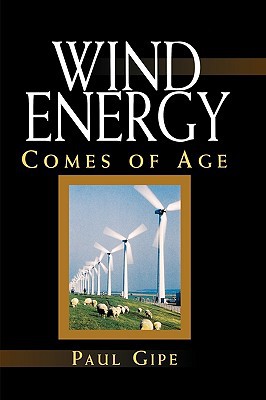

| WIND ENERGY COMES OF AGE Paul Gipe Christopher Flavin (Fwd.) New York: John Wiley & Sons, 1995 |
Rating: 5.0 High |
|||
| ISBN-13 978-0-471-10924-2 | ||||
| ISBN-10 0-471-10924-X | 536p. | HC/BWI | $175.00 | |
If there is an apostle of wind energy, Paul Gipe is it. Since the days when it was a tax shelter for dentists, he has been writing about, participating in, and proselytizing for this form of alternative energy. This book is as near to a technical sourcebook on machines to generate electrical power from wind as you will find in a public library. Paul Gipe has been involved in the field for some 35 years, and is still active at his home base of Tehachapi, California — one of the best wind resources in the United States.
"During the 13 years that I have followed and written about the wind power industry, I have seen its total output grow by a factor of 200. In that time, it has gone from being a glitzy tax shelter for wealthy dentists and Hollywood moguls to a serious global industry, with 1994 revenues of more than $1 billion.. Even more dramatic changes are ahead, however, for wind power is starting to figure prominently in many national energy plans, and could become a major source of income and employment in some countries." "At a time when scientists are increasingly concerned about carbon dioxide emissions from coal plants, and the nuclear industry is dying, the significance of a major new source of electricity is clear. In the U.S., wind potential of just three states—North and South Dakota and Texas—could supply all the country's electricity. At the global level, the total wind potential is estimated to be roughly five times current electricity use." – C. Flavin, pages xiii-xiv |
In his classic The Generation of Electricity by Wind Power, E. W. Golding derived an expression for the power the wind carries (page 143). From the formula for kinetic energy and the mass of air moving through a unit of area, the power in the wind in Watts is therefore
where ρ is air density, A is area intercepting the wind flow, and V is wind velocity (speed).
Something about the units bothers me: How does this yield power in Watts?
And then there's the theoretical efficiency of a wind turbine in capturing power from the wind. In 1920, Alfred Betz found this to be 59.3% (page 152).
Gipe has written several books on wind energy, including two new ones that I have not yet seen. I look forward to reading them. This one is a very useful compendium of information on the subject. It covers the basics of wind-turbine design parameters: output vs. wind speed, types of rotor speed control, advantages of fixed- vs. variable-speed generators, and much more. It also provides extensive discussion of the "soft" aspects of the technology, including siting considerations, noise abatement, esthetics, and impacts on wildlife (i.e. bird kills.) There is also a good bit of history. A highlight of this is his account of the derision which the Eiffel Tower faced upon its completion. It's now the pride of Paris. Gipe foresees wind-turbine towers finding a similar acceptance.
One of the best features of the book is Gipe's account of his own involvement. He's been to a number of community meetings in California where wind farms were proposed and opposed. Some of his bias against the opponents comes through. I think I can safely assume it's justified, but it's bias nonetheless. To that caveat I'll add two others: I'm not sure he's technically trained, and some errors I've seen lead me to suspect the technical data in this book should be checked before cutting metal based on it. Also, Gipe has a bias against aerospace technology. Again, this may be fully justified, but he twice derides "aeroderivative" technology for what don't seem to be good reasons.
There is a bevy of grammatical errors, whether due to Gipe or to his editor I cannot tell. And he makes a few technical errors, misstates a few things, and omits some information he apparently planned to supply, as noted in my Errata list. But none of this detracts overmuch from the value of the book.
There are plenty of tables throughout the text, along with plenty of well-chosen photographs, and there are drawings of the innards of various turbines. Each chapter is thoroughly end-noted. Appendices give a reading list, organizations to contact for more information, and a series of tables showing annual energy output for turbines of varying sizes versus wind speed.

 To contact Chris Winter, send email to this address.
To contact Chris Winter, send email to this address.